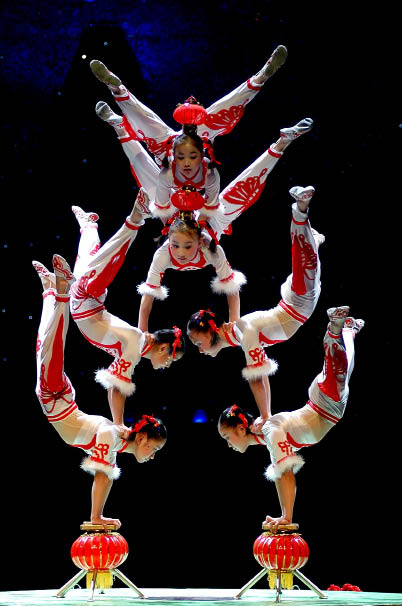| Birthplace of the Chinese Circus
By staff reporter XING WEN
|
 |
|
Teenage angst in Wuqiao gets channeled into pushing different kinds of limits. |
ACROBATIC arts have a very long history in China and they are also the root of the Chinese circus tradition which counts as a precious cultural heritage. Several places in China are renowned for acrobatics, and among them are Liaocheng of Shandong Province, Yancheng of Jiangsu Province, and Tianmen of Hubei Province. In Wuqiao County in Hebei Province however, it looks like acrobatics may be the only game in this town of 280,000. Fully 10 percent of its small population is engaged in acrobatic-related work.
The history of acrobatics in this region can be traced back to the Qin Dynasty (221-206 BC), but the rudiments of acrobatics originated much earlier than that. In ancient times people hunted for game or went fishing, sometimes having to cross mountains and rivers to dodge wild animal attacks and natural hazards. Severe circumstances taught our ancestors to be nimble and use acrobatic skills to stay out of trouble.
Eventually physical dexterity became somewhat celebrated in its own right. Frescos of the Northern and Southern Dynasties (420-589) unearthed in Wuqiao, some 300 km south of Beijing, illustrate acrobatic feats such as handstands and plate spinning. Nevertheless, Wuqiao acrobatics did not become famous until the Yuan Dynasty (1271-1368). Neighboring Henan Province was the center of the art when the national capital sat in that region, but later the Yuan Dynasty selected Beijing as the capital. Nearby Wuqiao County began to prosper and local acrobats soon won kudos nationwide. By the Qing Dynasty (1644-1911), Wuqiao acrobatics had reached its golden age, but even today it is widely acknowledged as home of the art.
Naturally the acrobatic arts are very popular among Wuqiao locals. There is a saying: "All people in Wuqiao, even 99-year-olds and toddlers, are acrobats." At present, the county is home to nearly 1,000 practitioners, more than 30 troupes and over 40 acrobatic training schools. Strolling around here it's easy to see how well integrated it is into daily life. Children somersault on streets; youngsters keep umbrellas balanced on their noses; farmers practice plate spinning next to their fields; at wedding banquets, bride and bridegroom distribute sweets and cigarettes to guests using sleight of hand and other magic tricks. Consciousness of the art form and widespread practice explains why the rural enclave has been a leading incubator of master acrobats for centuries and why classic stunts by the score were initiated here.
Acrobatics is not simply a display of physical flexibility and control, but a mixing of various art forms including music, dance, gymnastic technique and so on.
| 